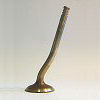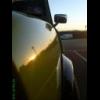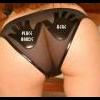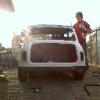A lot of people assume a Mini is a Mini and there is very little difference in body shells between years and maybe even decades, but they are wrong. After looking hard for a genuine car I've learned that there are many differences, some quite subtle, between early 1970s tax exempt shells and late 70s onwards. At the end of this post I've listed the differences between pre '73 body shells and later versions with the idea that anyone who has read this guide will have enough knowledge to spot the ringed or re-shelled vehicles.
Definitions: Re-shelling is transferring the majority of components and the identity from one car into a different body shell. Ringing is transferring of the identity of a car, usually by just swapping VIN and number plates.
To set things straight the re-shelling of a car with a secondhand shell is not illegal. It is allowed but must be declared to the DVLA, after which the vehicle will be the subject of an SVA test. If it passes the test it will be issued with a new registration number. The car will not retain its age, identity or tax exemption status as a historic vehicle. The use of a secondhand shell means the car cannot retain its original identity no matter how many of the original components are used in the replacement shell. The only way to re-shell a car and retain its identity is to use a new shell, currently produced by BMH for £3,600 (including bonnet, doors and boot).
So what does this mean to the potential buyer of a re-shelled or ringed car, and does re-shelling or ringing really hurt anyone except the tax man? The answer to this is yes, it hurts you, the new owner in several ways. If you buy one of these cars you'll almost certainly pay over the odds for the vehicle as tax exemption adds several hundred pounds to the value of a Mini. You may well not be insured as the car is not as declared to the insurance company. If you buy and drive a ringed or re-shelled car what do you do when it comes to selling it? Do you declare it to the DVLA and possibly write it off, or sell it on hoping the new owner doesn't find out, or more importantly, have an accident? If you're found out the police will want a word and the DVLA will want all the road fund license you've avoided paying over the years, plus a fine. I assume this holds true even after you've passed the car on to a new owner. DVLA aren't known for their sunny disposition and I believe its unlikely they will say "Lets forget about the 5 years road tax you evaded because someone else now owns the car". This means you'll never be rid of the thing once your name has been on the V5, it may come back to haunt you years later.
Which tax exempt model are you looking to buy? As a point of interest, to qualify for tax exemption the car must have been manufactured (not necessarily registered) before January 1st 1973. This means some cars registered in the first few months of 1973 may be eligible for historic vehicle status. The MkI and MkII cars (produced from 1959-1969) have external door hinges, sliding windows and are very different from later Minis. It is plainly obvious to most people if these are wrong. The MkIII is the version I'm talking about here and was produced between 1969 and 1976. There is of course a grey area, later MkIII cars ('73 to '76) have many of the features of the early MkIII '69 - '72 tax exempt vehicles. It is much harder to spot, say, a '71 car re-shelled in a '75 shell. MkIV cars were produced from 1976 onwards.
I've compiled a list of things to be aware of if you are looking at a tax exempt MkIII Mini ('69-'72). I've owned a couple of pre 1973 cars and numerous later models, the differences I've logged result from observation rather than detailed research, if I've made any mistakes please correct me. This is by no means a comprehensive list but it should give you a chance of spotting the car that is not genuine. The differences listed only apply to the shell itself as any component can be swapped over from the original vehicle, though many people don't seem to bother to swap even the most obvious of things. Finally, I wasn't looking at Clubmans, vans, estates or pickups and I believe some differences listed below don't necessarily apply to these models.
For the re-shelling or ringing of a MkIII model into a later shell you need to look at the following (listed roughly from front to back of the car):
Front subframe tower mounts. MkIII. Twin bolt mountings on the engine bay cross member.
[attachment=85959:Twin_bolt_1_a.JPG]
MkIV cars onwards have a large single bolt design.
[attachment=85958:Twin_bolt_2_a.JPG]
Front subframe lower rear mounts. The MkIII front subframe bolted directly to the bodyshell under the drivers and passengers feet. MkIV subframes have a rubber mount between the subframe and the body. Later car shown.
[attachment=85960:Subframe...unts_2_a.JPG]
Heater hose holes. MkIII heater hoses passed through the horizontal plate used to cover the clutch & brake master cylinder mounting holes for left hand drive cars. At some point in time later models were fitted with staggered oval holes above the cross member in the bulkhead. Later car shown.
[attachment=85961:LMP_12_small.JPG]
Cross member triangulation. All cars have a strengthening plate welded between the cross member and inner wing in the engine bay. MkIII cars have a small triangular hole and a couple of round holes in this plate. There are normally a few obvious spot welds holding the plate on.
[attachment=85962:LMP_14_small.JPG]
[attachment=85963:LMP_16_small.JPG]
MkIV cars have the triangular hole lengthened downwards turning the triangle into a rhombus, a tapped raised boss on the offside plate and four distinctive 1cm sized holes in the lower half of the plate exposing the cross member behind.
[attachment=85964:LMP_4_small.JPG]
Center binnacle captive bolts. In the engine bay MkIII cars have six captive square head bolts on the bulkhead and are used to secure the centre binnacle. Later cars fitted with instruments in front of the driver are missing the middle pair (3 & 9 o'clock position).
Front inner wheel arches. MkIII front wheel arches below the air vent hole are plain, later cars have a strengthening crease about 1" wide running from parcel shelf height to the floor. This can be seen by looking under the wheel arch. Later car shown.
[attachment=85965:P1020898_b.JPG]
Front subframe lower rear mount holes. The rear arms of the front subframe are fixed to the body with two bolts each. MkIII cars have one hole in the toe board and one hole in the floor on each mount, later cars have both mounting holes in the toe board.
[attachment=85966:Subframe...unts_3_a.jpg]
Gear lever hole. Earlier cars have a square hole for the gear lever in the exhaust tunnel biased towards the passenger, later cars have a larger rectangular hole in the center of the tunnel.
[attachment=85967:Gear_lever_1_a.jpg]
Exhaust tunnel. Earlier cars have a distinctive bulge on the drivers side of the exhaust tunnel next to the gear leaver, missing on MkIV and younger cars.
Cross member. MkIII cars have a step up from the front exhaust tunnel to the cross member. On MkIV cars the front exhaust tunnel is flush with the cross member.
[attachment=85968:LMP_11_small.JPG]
Handbrake. MkIII cars have a twin cable handbrake and twin adjusting nuts, one each side of the lever, the twin cables pass through their own holes in the floor. Later cars have a single cable on the handbrake lever, single cable hole in the exhaust tunnel and different handbrake mounting brackets. Later car shown.
Front belt mounts. MkIII cars have the front safety belt inertia reels mounted on the inner sills just in front of the rear bins. Later cars have the reels mounted inside the rear bins on distinctive welded in mounts. Later car shown which has both fixings.
[attachment=85969:Front_be...unts_2_a.JPG]
Ashtrays in rear pockets. MkIII cars have welded in ashtray mounts at the front of the rear bins (bringing the total ashtray count to four). These were deleted on later cars.
[attachment=85970:LMP_1_small.JPG]
Rear belt mounts. MkIII cars have no provision for rear seatbelts mounting points (though there are holes in the correct positions punched through the rear seat back).
[attachment=85971:LMP_5_small.JPG]
Later cars have strengthening bars in the boot with captive nuts.
[attachment=85974:LMP_18_small.JPG]
Later cars also have belt mounting points on the C pillars.
[attachment=85972:LMP_6_small.JPG]
Rear shelf speaker holes. MkIII cars have a pair of small holes for a single centre mounted oval speaker on the rear parcel shelf. Later cars have these small holes and a couple of large holes in the parcel shelf for larger speakers, one on each side of the original speaker. Over the years it's quite possible someone has cut holes for larger speakers. If these large holes have a return flange this means they have been stamped out in the factory, a giveaway that the parcel shelf is not an original MkIII panel.
Hole in rear seat back. MkIII cars have a large circular or oval hole punched in the centre of the rear seat upright. This will have a return flange on it. Later cars are missing this hole.
[attachment=85975:Rear_seat.JPG]
Roof gutter. Early cars have a horizontal slit in the roof gutter for drainage at each corner close to, but not directly above the vertical seam. Early cars also have a full length drip rail welded under the roof gutter on each side of the car.
[attachment=85976:Gutter_1_a.JPG]
Later cars have a square section of gutter missing directly above each vertical seam and no drip rail.
[attachment=85977:Gutter.jpg]
Panels may well have been replaced over the years, inner wings, boot floor, even a whole floor may be replaced but it's very unlikely that a car will loose all of its identifying marks. If the seller tells you every panel that had a distinctive trait has been replaced with later panels don’t believe him.
There are many other differences between Mk3 cars and later models including a smaller fuel tank, smaller square clutch and brake pedals, different switches and steering column. The heater front panel, dynamo, voltage regulator and interior trim along with a host of smaller items are different but these can all be changed. Remember, it is the shell that's important, not the components.
If you are after a tax exempt Mini good luck, they are out there and it's nice to have one, just don't get caught out. Once you've identified your genuine car and bought it enjoy it. To those of you who have read this purely out of interest have fun spotting the fakes.
Edited by SolarB, 05 June 2009 - 08:10 AM.






















